A chicken with a striking black and white striped appearance, the Plymouth Rock chicken is one of the most historically popular chickens in the United States. These lovely chickens are friendly, easy to keep, and are good sources of both eggs and meat.
If you are looking for a cold hardy, healthy breed that could be considered dual purpose to add to your flock of chickens on your homestead, the Plymouth Rock is an excellent choice. Learn about Barred Rocks and other recognized varieties as well as Plymouth Rock roosters and chicks.
Plymouth Rock Chicken Background
The breed known as the Plymouth Rock was first recorded in Boston in the mid 19th century. The breed was named after the location where the Pilgrims first lived when they came to the New World.
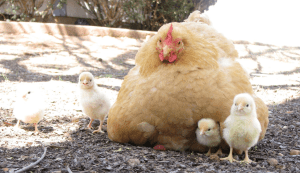
For some reason, the breed vanished from historical records for about twenty years. Later, they reemerged in records of a poultry show in 1869. The Plymouth Rock had been crossed with a few other breeds to improve it. The breeders emphasized the barred coloring and wanted to have a guarantee of clean legs in their Plymouth Rock chickens. In 1874, the Plymouth Rock was recognized as a distinctive breed and admitted to the first American Standard for Excellence.
The original Plymouth Rock featured a barred color pattern. They are called Barred Rocks. This refers to a color pattern of alternating black and white stripes. However, in time other colors and patterns were developed. Currently, there are seven different color variations in the Plymouth Rock chicken breed.
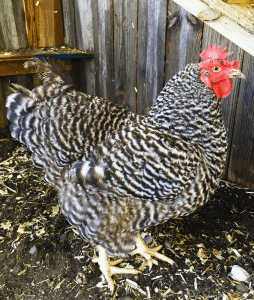
This breed of chickens was one of the most popular ones in the United States up until after World War II. Chicken keepers liked it because it was an excellent source of meat and eggs, making it a good dual-purpose chicken. Eventually however, the commercial meat industry turned to other breeds as broilers, and it lost acclaim.
In recent decades, the Plymouth Rock has been growing in popularity, as more chicken keepers look for healthy chickens to supply meat and eggs for their families.
Temperament & Personality
By most accounts, the Plymouth Rock chicken is a joy to keep. These hens are friendly and docile with charming and sweet personalities. Plymouth Rock hens make great pet chickens. They are often the type of chicken that will jump up into one’s lap and seek affection from their owners. So if you are seeking a lap chicken, consider Plymouth Rocks. You may find they follow you around seeking treats.
Plymouth Rock chickens are also very curious. They love to explore and try new things.
The Plymouth Rock chicken will not cause problems in a mixed flock. Unlike dominant breeds, they won’t pick on other birds and push them around. They seem to get along with everyone pretty well. Because they are relatively large birds, the other more aggressive breeds will likely not try to pester the Plymouth Rock either.
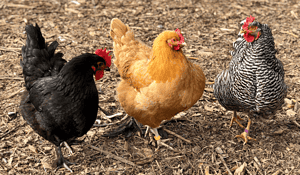
Because the Plymouth Rock is so tame, this breed is one of the best choices for beginner chicken keepers to have. Additionally, if you have children who want to take on a chicken project such as 4H or Future Farmers of America (FFA), you cannot go wrong with the Plymouth Rock chicken.
The Plymouth Rock chicken is fairly quiet, so it may be a good choice for a suburban backyard flock. However, because of its size, owners should ensure that the backyard coop and enclosed run has adequate space.
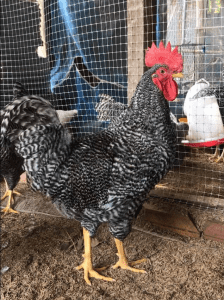
Appearance
Plymouth Rock chickens have sturdy, well muscled, triangular shaped bodies. Their feathers are very full and loose, giving them a very puffy, soft appearance. They have clean, yellow colored legs with four toes on each foot.
The Plymouth Rock comb and wattles should be a bold, cheerful red. They have single, five pointed combs and reddish brown eyes.
Hens weigh about 7.5 pounds and the roosters can weigh between 9 and 10 pounds.
There is a bantam variety of the Plymouth Rock chicken. These miniature versions of the popular chicken weigh about 2.5 pounds for the hens and 3 pounds for the roosters.
Plymouth Rock Varieties
There are seven color variations of the Plymouth Rock. The barred color pattern is the most popular, featuring alternating stripes or bars of black and white. This variety is called Barred Rock. The Barred variety closely resembles the Dominique chicken.
Barred Rock roosters have larger white stripes than black ones. Barred Rock hens’ black and white stripes are mostly equal in width.
The second most popular color pattern for Plymouth Rock chickens is the white color. Some commercial poultry operations raise White Rocks for meat. They can also be called white Plymouth Rocks.
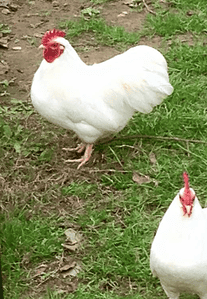
Other color patterns include the Buff Rock which are golden brown. These chickens somewhat resemble the Buff Orpington, though their feathering is not as fluffy as the Buff Orpington.
The Columbian Rock has white feathering on the body, but features black feathers on the tail, neck and wing tips
The Blue Rock has a lovely bluish gray body with darker feathering on the head. Blue Plymouth Rock chickens tend to look more gray than true blue.
Partridge Rock chickens have reddish brown plumage, fading to black feathers on the back, breast, and body.
Silver Penciled Rocks are eye-catching and rare. Their feathers are so pretty that fishermen use them for tying flies for fly-fishing. These gorgeous roosters have silvery penciled heads with black breasts, white wing tips, and silver penciled back and tail feathers. The hens have an overall white with black penciled feather pattern on their entire bodies.
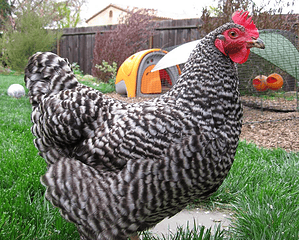
Plymouth Rock Hens
These chickens are friendly, curious, and tame. Because they are a heavier breed, these hens may take a bit more time than is typical to start laying eggs. Generally, Plymouth Rock hens start laying around the age of 6 to 8 months.
The hens lay fairly consistently for about three to four years, stopping only to molt once or twice a year. After four years, their laying will begin to taper off.
Because they are a heritage breed, it is not unusual for Plymouth Rock hens to go broody. Remember the history of the breed: they were created for farmers, long before incubators and brooders were invented. Farmers liked having hens that would raise chicks to increase the flock. These hens will sit on a nest of eggs for the full 21 days needed to hatch the babies. Then, they will take excellent care of their brood until the chicks are old enough to care for themselves. Overall, Plymouth Rock hens are great mothers.

Roosters
The Plymouth Rock rooster is actually fairly tame, as far as roosters go. They are overall very sweet and calm birds. However, as with all male chickens, as they go through puberty, they may occasionally act out. Particularly when they are between five and right months old, remain aware of your roosters and keep an eye on small children and small pets when around the chickens.
Also, remember the natural instincts of a rooster. Their instinctual desire is to protect their flock of hens. If you pester the hens, or your dog bothers them, the rooster may react aggressively. However, with Plymouth Rocks, their roosters generally have a reputation of being easy to keep.
Chicks
As baby chicks, these adorable birds are covered with a charcoal-black fuzzy down feathering. There is a bit of grayish white peeping through as well, particularly on the chin, chest, and tips of the wings. These chicks also have some white or cream spots.
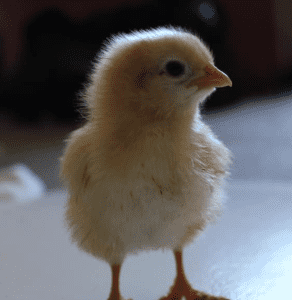
One nice thing about the Barred Plymouth Rock is that these chicks are considered auto sexed. This means that the male chicks have different colored feathering than the females. You can tell at hatching which chicks are boys and which are girls without having to examine their vents.
There are several differences between male Barred Plymouth Rock chicks and female Barred Plymouth Rock chicks. First, the legs of the males are significantly lighter in color than the females. Young cockerels will have a more orange colored leg while the females have a charcoal gray color.
As far as down color, male Barred Plymouth Rock chicks are lighter colored than the females. Also, in male chicks, the white or light colored spot on the head is large and bold. Females usually have a smaller, less distinct head spot. Remember, though, these differences only apply to Plymouth Rock chicks in the barred color pattern. Other color patterns do not have auto sexed chicks.
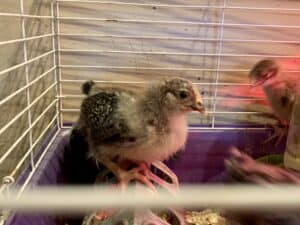
Plymouth Rock chicks are considered very quick growing. They will quickly lose their downy feathers and grow in their adult plumage. By around the age of 8 to 12 weeks, some of them may have grown large enough to butcher out as broilers.
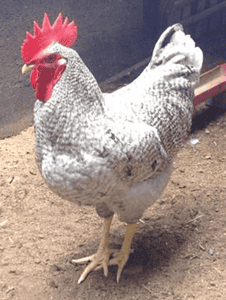
Egg Laying
The Plymouth Rock can be considered to be one of the reliable layers, if not the most prolific egg layer in the mixed flock. They do have fairly good feed conversion, giving you a fair number of eggs for the feed consumed.
Each Plymouth Rock hen will lay about 3 or 4 large brown eggs per week, especially for her first three or four years of life. This equates to about 200 eggs per year for the average Plymouth Rock hen. However, after she passes the four-year mark, she may begin to taper off in her egg productivity.
They are considered to be productive layers and can be considered among the best egg laying chickens, along with Rhode Island Reds.
Plymouth Rock Meat
Homesteaders appreciate the dual-purpose nature of the Plymouth Rock. As well as being a reliable layer, these birds dress out well for table meat. You can use your hens to lay eggs for market, but the roosters will be excellent as meat birds. Around 15 weeks of age, your roosters will dress out to about a four pound broiler chicken.
One nice thing about Plymouth Rock chickens is that they grow slowly enough that you will not have to process all your meat birds at once. You can, over the course of two or three months, process your meat chickens, and the cockerels will still remain healthy and continue to grow.
When raising these chickens for meat, be sure to switch your meat flock from chick starter to a broiler feed to ensure maximum growth in the shortest amount of time. This switch should take place around 4 to 6 weeks of age.
Of course, meat raised from a Plymouth Rock chicken will be slightly different from what you will buy from the grocery store. These chickens have a lower ratio of breast meat to dark meat, which is typical for most heritage breeds. However, as long as you butcher before nine months, your chicken will be tender, juicy, and flavorful.
After the age of nine months, you risk having your chicken become tougher and stringier. If you are butchering older birds, you may want to either grind the chicken or simply stew it for the nutritious and delicious broth that a free-range chicken will yield.
If you have a “slow food” market in your area, Plymouth Rocks are an excellent breed that you can raise for meat to sell.
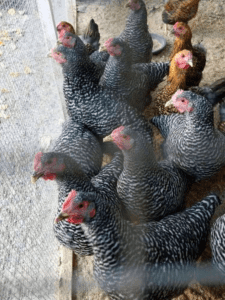
Raising Plymouth Rocks – Special Care
Because Plymouth Rocks are larger in size than many chicken breeds, you may need to pay close attention to the size of your chicken yard and coop. You also need to provide adequate roosting space for them.
Plymouth Rocks need about 10 to 20 square feet of space in an enclosed run, or you can allow them to free-range. In the coop, you should ensure about 5 square feet of space for each bird. They also need about 18 to 20 inches of roosting space per bird.
Be sure that you provide adequate space for your chickens or they will get irritable with one another and begin to peck and pester each other. This will lead to other undesirable behaviors which will cause a drop in production.
Other than allowing more space for this rather large breed of chicken, the Plymouth Rock mainly needs exactly what most other breeds of chickens need — good food, clean water, and dry shelter from the elements.
Health Considerations
Overall, the Plymouth Rock chicken is a very healthy and low maintenance kind of chicken. If you need a hen that requires very little special care, this may be the breed for you. However, there are a few considerations of which you should be aware. They are more cold hardy than they are heat tolerant.
First of all, the heavier breeds do seem to suffer a bit more in extreme heat. Their beautiful, fluffy feathering can make them overheat in the dog days of summer. However, as long as you provide plenty of cool water and enough shade, they will make it through okay.
You may want to refill their water two or three times a day to make sure that it says cool and fresh. Also, make sure that air can circulate in their coop to help the chickens stay cool when humidity and temperatures rise.
Additionally, the large single combs of the Plymouth Rock chicken may be a bit more susceptible to frostbite in extremely cold weather. This is very painful for the chickens since their combs are so sensitive.
To prevent frostbite, you may want to spread a bit of petroleum jelly on their combs when the weather gets really cold. If you live in an extreme Northern climate, during the fall, you should double-check your chicken coop to make sure it is adequately insulated and free from drafts.
FAQ’s
What color eggs do Plymouth Rock hens lay?
Plymouth Rock hens lay brown eggs.
Are Plymouth Rock chickens good eating?
In addition to providing tasty meat, Plymouth Rocks provide a good ROI making them a good dual-purpose breed for meat and eggs in your backyard.
How long does a Plymouth Rock chicken live?
A Plymouth Rock’s lifespan is typically 10 years up to 12 years. Feeding and watering them well and keeping Plymouth Rocks safe from extreme weather and predators will help ensure a long life. If raising them in a mixed flock, be sure to keep them with other calm birds. Also be sure the hen-to-rooster ratio is 8 – 10 hens per rooster.
Doing all of these things will help ensure a stress-free life for Plymouth Rocks which will provide better quality eggs and meat as well as a long life. If you don’t cull them for meat, how long do chickens live depends a lot on the care they receive.
Are Barred Rock and Plymouth Rock chickens the same?
Barred Rocks and Barred Plymouth Rocks refer to a variety of Plymouth Rock chicken. Barred Rocks look a lot like Dominque chickens. In addition to Barred Rocks, which are black and white Plymouth Rocks, there are six other recognized varieties. The other varieties are White Rocks, Buff Rocks (tan and light brown feathers), Silver-Penciled Rocks (silver with black and white), Partridge Rocks (reddish brown) and Blue Plymouth Rocks (gray with blue-ish feathers).
A “Plymouth Rock” chicken can be called by their color and “Rock” after it but they are all Plymouth Rock chickens.
Blue Plymouth Rock Chicken, Barred Rocks and Other Varieties
Originally bred in the United States, Plymouth Rocks are large-sized chickens. They have a broad and deep body. The breed typically has six or more large white feathers, with prominent black tips on the wings.
During the 19th century, many breeds of chickens were bred as dual-purpose birds to produce both meat and eggs. The Plymouth Rock was one of the most popular among those breeds during this time period. It became one of the first American breeds to be admitted to the Standard of Perfection for chickens.
The Plymouth Rock has since been accepted into all North American poultry associations, as well as a number of European registries and standards for poultry breeding.
Chicken breeds that make excellent egg and meat options include the Rhode Island Red and the Plymouth Rock. Other great dual purpose breeds include the New Hampshire, Orpington, and Wyandotte.
Crosses between various chicken breeds are also common in these flocks. These chickens provide an extremely reliable source of meat for small hobby farms. Bantam breeds are a popular option for small-scale flocks.

